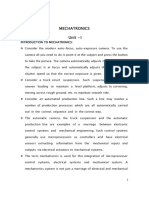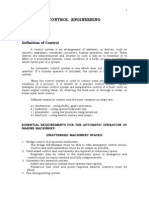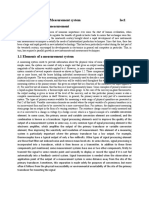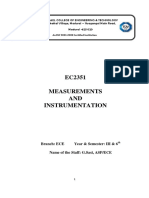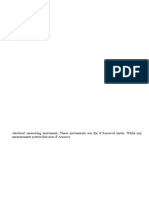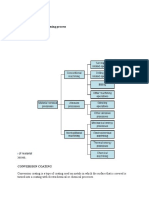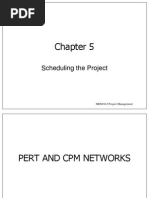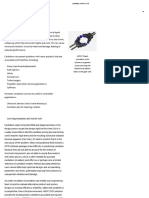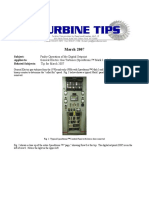Mechatronics QB
Mechatronics QB
Uploaded by
Karthik Perumal SwamyCopyright:
Available Formats
Mechatronics QB
Mechatronics QB
Uploaded by
Karthik Perumal SwamyCopyright
Available Formats
Share this document
Did you find this document useful?
Is this content inappropriate?
Copyright:
Available Formats
Mechatronics QB
Mechatronics QB
Uploaded by
Karthik Perumal SwamyCopyright:
Available Formats
DEPARTMENT OF MECHANICAL ENGINEERING SUB CODE: SEMESTER:VII UNIT- I INTRODUCTION 1. Define Mechatronics.
The term Mechatronics is used for the integration of microprocessor control system, electrical systems and mechanical systems. Mechatronics is defined as the integration of precision mechanical & electronic control for the development of smart products & process. 2. What is a system? Give an example. A system can be considered as a box, which has an input, and an output and where it is not concerned with what goes on inside the box but only the relationship between the output and the input. Example: A motor may be thought of as a system, which has as its input electric power and as output the rotation of a shaft. 3. What is a measurement system? A measurement system can be considered as a black box, which is used for making measurements. It has as its input the quantity being measured and its output the value of that quantity. 4. Write about the sensor and give an example. A sensor, which responds to the quantity being measured by giving as its output a signal which is related to the quantity. Example: A thermocouple is a temperature sensor. The input to the sensor is a temperature and the output is an e.m.f. which is related to the temperature value. 5. Write about the signal conditioner? A signal conditioner takes the signal from the sensor and manipulates it in to a condition, which is suitable for either display, or in the case of a control system, for use to exercise control. 6. What are the two basic forms of the control system? The two basic forms of the control systems are, a. Open loop control system. b. Closed loop control system. Type Advantage Disadvantage Open Loop a. It is being relatively simple inaccurate since there is no b. Low cost correction of error c. Good reliability SUB:MECHATRONICS YEAR: IV
Closed Loop
Accurate in matching the actual to the required values.
a. More complex b. More costly c. Greater chance of breakdown as a consequence of the greater number of components.
7. What are the elements of the closed loop control system? The various elements of a closed loop control system are, a. Comparison element b. Control element c. Correction element d. Process element e. Measurement element 8. What are the two types of feedback loop? The two types of feed back loop are, a. Positive feed back loop b. Negative feed back loop. "The feedback is said to be negative/positive feedback when the signal; which is feed back, subtracts/adds from the input value. It is required to control a system. The control elements decide what action to take when it receives an error signal" 9. What are the types of control elements? There are two types of control elements. They are a. Hard wired systems b. Programmable systems. 9. What are the various elements of a closed loop system for a person controlling the temperature? The various elements of a closed loop system are, 1. Controlled variable 2. Comparison element 3. Error signal 4. Control unit 5. Measuring device For example, Controlled variable - The room temperature Reference value (The required room temperature) Comparison element - The person comparing the measured value with the required value of temperature.
Error signal - The difference between the measured and required temperatures Control unit - The person Correction unit - The switch on the fire Process - The heating by the fire Measuring device - A thermometer 10. Write about the Mechatronics approach in a micro-processor controlled washing machine? In the microprocessor-controlled washing machine, a mechanical system has become integrated with electronic controls. As a consequence, a bulky mechanical system is replaced by a much more compact microprocessor system, which is readily adjustable to give a greater variety of programs. 11. What is the larger scale application of Mechatronics? A larger scale application of Mechatronics is a Flexible Manufacturing engineering System (FMS) involving computer controlled machines, robots, automatic material conveying and overall supervisory control. 12. List some of the applications of Mechatronics? 1. Home Appliances: Washing machine, Bread machines etc 2. Automobile: Electrical fuel injection, Antilock brake system 3. Aircraft: Flight control, Navigation system 4. Automated Manufacturing 13. What are the components of Mechatronics System? 1. Actuators 2. Sensors 3. Signal Conditioning units 4. Digital control devices 5. Graphical Displays 14. What is meant by a system in Mechatronics? The System is the group of physical component combined to perform a specific function. Any mechatronics devices consists of systems 15. What are the main applications of mechatronics? Washing machines, dish washers, micro ovens, cameras, camcorders, robots, automatic conveyors, computer-controlled machines 16. Draw the block diagram of measurement system. Quantity measured Transducer or Sensor Signal Processor Recorder value
17. Sketch the graphical representation of mechatronics system. Actuators Solenoids DC motor Stepper motor Sensors Switches Straingauge Thermocouple Potmeter MEMS Input Signal Conditioning and Interfacing Circuits Flters Amplifier A/D,D/A
Digital Control Architecture Logic Circuits Microcontroller PLC Control Algorith
Mechanical System
Graphical Displays LEDs LCD Digital Display CRT
Output Signal Conditioning and interfacing D/A,D/D Amplifier Power Transistor
18. Obtain the basic functions of control systems. 1. To minimize the error between the actual and desired output 2. To minimize the time response to load changes in the system 19. What are the types of control system? Open loop system Closed loop system 20. List down the requirements of control systems. Stability Accuracy Response 21. Give an example for open loop system and closed loop systems. 1. Closed loop system Automatic water level controller 2. open loop system - Electric fire
22. Compare open loop control system and closed loop control system. Open loop systems Closed loop systems It is suitable where accurate positioning of the tools is not required System is very simple The feedback signal controls the table position accurately Is used almost in all automation process Its not suitable for rough works Error is currently checked and rectified
It is suitable for rough works Error is not currently checked and rectified
23. What are the basic elements of feedback system? Forward path Feedback path Error detecting device Amplifier Compensating network 24. What is meant by sequential control what are the two modes in it? A system operating with sequential control is one where a set of prescribed operations are performed in sequence. The modes are, Event based mode Time based mode 25. Give an example for event-based and timebased sequential control. Time-based Water Heater Event-based Domestic washing machine
UNIT II SENSORS AND TRANSDUCERS 1. What is the purpose of a sensor? Sensor is used for an element which produces a signal relating to the quantity being measured. I.e., an electrical resistance temperature element, the quantity being measured is temperature and the sensor transforms an input of temperature into a change in resistance. 2. Define transducer? The term transducer is often used in place of the term sensor. Transducer is defined as elements that when subject to some physical change experience a related change. Thus, sensors are transducers. 3. What are the terms that define the performance of the transducers? 1. Range and span 2. Error 3. Accuracy 4. Sensitivity 5. Hysteresis error 6. Non linearity error 7. Repeatability / reproducibility 8. Stability 9. Dead band / time 10. Resolution 11. Output impedance. 4. Define static characteristics? The static characteristics are the values given when the steady state conditions occur. i.e., the values given when the transducer has settled down after having received some input. 5. Define dynamic characteristics? The dynamic characteristics refer to the behavior between the time that the input value changes and the times that the value given by the transducer settles down to the steady state value. Dynamic characteristics are stated in terms of the response of the transducer to inputs in particular forms. 6. What are the terms that you can find from the dynamic characteristics? 1. Response time. 2. Time constant. 3. Rise time 4. Settling time. 7. What is a displacement sensor? Displacement sensors are concerned with the measurement of the amount by which some object has been moved.
8. What is a position sensor? Position sensors are concerned with the determination of the position of some object with reference to some reference point. 9. What is a proximity sensor? Proximity sensors are a form of position sensor and are used to determine when an object has moved to within some particular critical distance of the sensor. 10. What are the two basic types of the displacement and the position transducers? The two basic types are, 1. Contact sensors 2. Non contact sensors. 11. Write about the strain gauged element? The electrical resistance strain gauge is a metal wire, metal foil strip, or a strip of semiconductor material, which is wafer like and can be stuck onto surfaces like a postage stamp. 12. Define gauge factor. The gauge factor is defined as the ratio of per unit change in resistance to per unit change in length. Gauge factor Gf= R/R L/L 13. Write about the gauge factors for different types of strain gauges? The gauge factor of metal wire or foil strain gauges with the metals generally used is about 2.0. Silicon p and n type semiconductor strain gauges have gauge factors of about + 100 or more for p- type silicon and 100 or more for n type silicon. 14. What is the capacitance of a parallel plate capacitor? The capacitance of a parallel plate capacitor is given by, C = A/d = roA/d Where = Permitivity of the medium/m r = Relative permitivity o = Permitivity of the free space = 8.85x10-12F/m A = Area of plates D = Distance between two plates 15. Define LVDT? The Linear Variable Differential Transformer consists of three coils symmetrically spaced along an insulated tube. The central coil is the primary coil and the other two are identical secondary coils, which are connected in series in such a way that their outputs oppose each other.
16. Determine the working Principle of LVDT? When there is an alternating voltage input to the primary coil, alternating e.m.f.s are induced in the secondary coils. With the magnetic core central, the amount of magnetic material in each of the secondary coil is the same. 17. What are the uses of LVDT? The uses are as follows. a. Widely used as primary transducers for monitoring displacements. b. Also used as secondary transducers in the measurement of force, weight and pressure.
18. Write about inductive proximity switch? Inductive proximity switch consists of a coil wound round a core. When the end of the coil is close to a metal object is inductance changes. This change can be monitored by its effect on a resonant circuit and the change used to trigger a switch. It can only be used for the detection of metal objects and is best with ferrous metals. 19. What is an encoder? An encoder is a device that provides a digital output as a result of a linear or angular displacement. 20. What are the two types of position encoders? The two types of position encoders are, a. Incremental encoders b. Absolute encoders. 21. What is an incremental encoder? An incremental encoder is used for the measurement of angular displacement. A beam of light passes through slots in a disc and is detected by a suitable light sensor. When the disc is rotated, the sensor produces a pulsed output with the number of pulses being proportional to the angle through which the disc is rotated. Hence, the angular position of the disc is determined. 22. Write about absolute encoder? An absolute encoder is used for the measurement of angular displacement. This gives an output in the form of a binary number of several digits, each such number representing a particular angular position. The rotating disc has three concentric circles of slots and three sensors to detect the light pulses. 23. What are the uses of photosensitive devices? Photosensitive devices can be used to detect the presence of an opaque object by it breaking a beam of light or infrared radiation, falling on such a device or by detecting the light reflected back by the object.
24. Write about Hall effect sensors? When a beam of charged particles passes through a magnetic field, forces act on the particles and the beam is deflected from its straight line path. A current flowing in a conductor is like a beam of moving charges and thus can be deflected by a magnetic field. 25. What is Hall co-efficient? The transverse potential difference is given by, V = KHBI Where, b KH = Hall co-efficient B = Magnetic flux density at right angles to the plate, I = Current 26. What are digital signals? Digital signals are discrete time signals in that they are not continuous functions of time but exist at only discrete times. 27. Why the signal conditioning is required? Signal conditioning of analogue signals requires components such as amplifiers filter circuits and digital signal microprocessor.
UNIT III ACTUATION SYSTEMS 1. Define Actuator. An actuator is an output device which performs useful works 2. Classify actuator based on motion. 1. Linear motion Single acting cylinder Double acting cylinder 2. Rotary Motion Air motors Rotary actuators 3. Flow Control valve 3. When is cascade control Needed? The need for cascade control will occur when a final control element experiences signal overlap i.e. when a trip valve mechanism is still held down , but the output signal has to been used and requires removal 4. Write down the principles of cascade control. A simple design procedure to determine the minimum number of groups in the circuit Evolve separate supply bus for each group Arrange selector valves to divert the supply to whichever is the active group 5. Mention the various components of a hydraulic system. Motor Filter Pump Pressure Regulator Control Valve Piston and cylinder 6. What is called a pneumatic system? System using gas for power transmission are called pneumatic systems and industrial system are usually based on air. 7. List down the components of pneumatic system. Motor driven compressor Air receiver Directional control Pneumatic cylinder 8. What is the purpose of using filters in the hydraulic systems?
Filters are used to prevent dirt or dust entering important elements of hydraulic system like valves, seals, etc. Filters are used to remove very finer particles. 9. What are the types of pumps used as energy source in a hydraulic system? Centrifugal Pump(Hydrodynamic Pumps) Positive displacement pump 1. Gear Pumps 2. Vane Pumps 3. Piston pumps 10. What are the factors to be considered for selecting compressors? The type of air compressor is selected dependent on quality of air, pressure and cleanliness 11. What are the uses of air receiver? An air receiver is used to store high pressure air and provide constant supply of air pressure in the pneumatic system regardless of varying and fluctuating consumption. It is used for the emergency supply of air to the system in case of power failure. 12. State the purpose of providing air dryers. The aim is to reduce the temperature of the air to a dew point which ensures that the water in the air condenses and drops out easily. 13. State the function of a control valve. The primary function of the control valve is to direct and regulate the flow of fluid from an energy source to various loading devices. Normally the control valves are used for the purpose of sensing, processing ,and controlling. They are used for: Allowing the passage of air/fluid and directing it to a loading line Cancel the signal by blocking its passage Alert or generate the signal Release the air to atmosphere or return the fluid to tank 14. List the different control valves. Directional control valve Non return valves Flow control valves Pressure control valves Combinational valves Solenoid valves 15. Define the term degrees of freedom.
The minimum number of independent displacement required to specify the system completely is called degrees of freedom 16. Define kinematic pair. The two links or elements are joined together to form a pair. If the relative motion between them is completely or successfully constrained, the pair is known as kinematic pair. 17. When is cascade control needed? The need for cascade control will occur when a final control element experiences signal overlap ie; when a trip valve mechanism is still held down, but the output signal has been use and requires removal. 18. List the features of synchronous motor. It operates at a current speed from no load to full load Power factor of the motor can be controlled easily 19. What is a stepper motor? A stepper motor is a rotating machine which converts a DC voltage pulse into a series of discrete rotational steps. Each step position is an equilibrium position without further excitation, this makes it ideally suitable for the use with digital control 20. What is stepper motor? A stepper motor is a device which transforms electrical pulses into equal increments of rotary shaft motion called steps. 21. What is servomotor? The motors used in automatic control systems or in servomechanism are called servomotors. They are used to convert electrical signal into angular motion. 22. What is synchro? A synchro is a device used to convert an angular motion to an electrical signal or vice versa. 23. At what conditions SPDT, DPST an DPDT switches are used? a. SPDT (Single Pole, Double Throw): When we require ON and OFF operation as the circuit is actuated, SPDT is used. b. DPST (Double Pole, Single Throw): When we need to turn two separate circuits ON and OFF simultaneously with a single switch, DPST is used. c. DPDT (Double Pole, Double Throw): When a switch is turned ON and OFF between N and O with double pole switches, DPDT is used. 24. What are the factors to be considered for selecting solenoids? a. The size of the mechanical load. b. The movement distance of plunger.
c. The type of electrical connections. d. The type of value of current and voltage. 25. What is the principle of relay? Relay is used for many control functions and essentially an electromechanical switch. It uses basic switching principles and solenoid actuation. 26. What is zener voltage? In the reverse direction, the diode conducts very little when the voltage is below the breakdown value. This critical limiting value of reverse voltage is known as zener voltage. 27. Name three output characteristics of transistor configuration. a. Saturation region b. Active region c. Cut-off region.
UNIT- IV CONTROL SYSTEMS 1. What is a microprocessor? A microprocessor is a multipurpose, programmable, clock driven, registers based electronic device that reads binary instructions from a storage device called memory, accepts binary data as input and processes data according to those instructions, and provides results as output. 2. What are the four components of a programmable machine? A typical programmable machine can be represented with four components. a. Microprocessor b. Memory c. Input d. Output. 3. Define the terms. a) Bus b) RAM c) ROM. BUS A group of lines used to transfer bits between the microprocessor and other components of the computer system. RAM Random Access Memory. Data is stored in a read / write memory. ROM Read only Memory. A memory that stores binary information permanently. The information can be read from this memory but cannot be altered. 4. What the types of languages used? The types of languages used are, a. Machine language b. Assembly language c. Low level language d. High level language. 5. What is a machine language? The binary medium of communication with a computer through a designed set of instructions specific to each computer. 6. What is a assembly language? A medium of communication with a computer in which programs are written in mnemonics. An assembly language is specific to a given computer. 7. What is low level language? A medium of communication that is machine dependent or specific to a given computer. The machine and the assembly language of a computer are considered low level languages. Programs written in these languages are not transferable to different types of machines.
8. What is a high level language? A medium of communication that is independent of a given computer. Programs are written in English lie words, and they can be executed on a machine using a translator (a compiler or an interpreter). 9. Differentiate a compiler and an interpreter? Compiler A program that translates English like words of a high level language into the machine language of a computer. A compiler reads a given program, called a source code, in its entirety and then translated the program into the machine language, which is called an object code. Interpreter A program that translates the English like statements of a high level language in to the machine language of a computer. An interpreter translates one statement at a time from a source code to an object code. 10. What are the two parts of an instruction? An instruction has two parts. Opcode Operation to be performed. Operand The operand can be data (8 or 16 bit), address, or register, or it can be implicit. The method of specifying and operand (directly, indirectly, etc.,) is called the addressing mode. 11. What are the types of bus? The types of bus are, a. Address bus b. Data bus c. Control bus. 12. Define the term , Data Bus, Address bus, Control Bus a. Address Bus A group of lines that are used to send a memory address or a device address from the MPU to the memory location or the peripheral and is unidirectional. The 8085 microprocessor has 16 address lines. b. Data bus A group of bi-directional lines used to transfer data between the MPU and peripherals and is bi-directional. The 8085 microprocessor has eight data lines. c. Control bus Single lines that are generated by the MPU to provide timing of various operations. 13. Write about the 16 bit register of a 8085 microprocessor? The 8085 has two 16 bit register. a. The program counter b. Stack pointer The program counter is used to sequence the execution of a program. The stack pointer is used as a memory pointer for the stack memory.
14. What are the two types of memories? The two types of memories are, a. Static memory (SRAM) b. Dynamic memory (DRAM) 15. Write about the SRAM? a. This memory is made up of flip flops, and it sores the bit as a voltage. b. Each memory cell requires six transistors. c. The memory chip has low density, but high speed. d. More expensive, and consumes more power. e. Also known as cache memory. 16. What are the advantages of DRAM? The advantages of DRAM are, a. This memory is made up of MOS transistor gates and it stores the bit as a charge. b. It has high density. c. Low power consumption d. Cheaper than static memory e. Economic to use when the system memory size is atleast 8K for small systems.
17. What are the disadvantages of DRAM? The disadvantages of DRAM are, a. The charge (bit information) leaks. b. Stored information needs to be read and written again every few milliseconds this is called refreshing the memory. c. Requires extra circuitry, adding to the cost of the system. 18. What is flash memory? The flash memory must be erased either in its entirely or at the sector level. The memory chips can be erased and programmed at least a million times. The power supply requirement for programming these chips 2was around 12V, but now chips are available that can be programmed using a power supply as low as 1.8 V. Hence, this memory is ideally suited for low power systems. 19. What are the interfacing devices? The bus drivers increase the current driving capacity of the buses, the decoder decodes the address to identify the output port, and the latch holds data output for display. These devices are called interfacing devices. The interfacing devices are semiconductor chips that are needed to connect peripherals to the bus system. 20. Write about buffer?
The buffer is a logic circuit that amplifies the current or power. It has one input line and one output line. The logic level of the output is the same as that of the input, logic 1 input provides 1 output. The buffer is used primarily to increase the driving capability of a logic circuit. It is also known as driver. 21. Define looping? The programming technique used to instruct the microprocessor to repeat tasks is called looping. A loop is set up by instructing the microprocessor to change the sequence of execution and perform the task again. This process is accomplished by using Jump instructions. 22. What are the types of loops? Loops can be classified in to two groups. They are, a. Continuous loop b. Conditional loop. 23. Write about the continuous loop? A continuous loop is a set up by using the unconditional jump instruction. A program with a continuous loop does not stop repeating the tasks until the system is reset.
24. Write about the conditional loop? A conditional loop is set up by the conditional jump instructions. The instructions check flags (Zero, Carry etc.,) and repeat the specified tasks if the conditions are satisfied. These loops usually include counting and indexing. 25. What are the instructions of a 8085 instruction set for data transfer from memory to the microprocessor? The 8085 instruction set includes three memory transfer instructions. They are, a.MOV R,M : Move from Memory to Register b.LDAX B/D : Load Accumulator Indirect c.LDA 16 bit : Load Accumulator Direct 26. What are the instructions of a 8085 instruction set for data transfer from microprocessor to the memory? The 8085 instruction set includes three memory transfer instruction. They are, a. MOV. R,M : Move from Memory to Register b. STAX B / D : Store Accumulator Indirect c. STA 16 bit : Store Accumulator Direct d. MVI M, 8 bit : Load 8 bit data in memory. 27. What are the opcodes related to rotating the accumulator bits? The opcodes related to rotating the accumulator bits are, a. RLC Rotate Accumulator Left through Carry
b. RAL Rotate Accumulator Left c. RRC Rotate Accumulator Right through Carry d. RAR Rotate Accumulator Right
28. What is dynamic debugging? After the steps have been completed in the process of static debugging, and if the program still does not produce the expected output, attempt is made to debug the program by observing the execution of instructions. This is called dynamic debugging. 29. What are the tools used for dynamic debugging? The tools used for dynamic debugging are, a. Single step b. Register examine c. Break point. 30. Write about single step? The single step key on a keyboard allows to execute one instruction at a time, and to observe the results following each instruction. Generally, a singlestep facility is built with a hard-wired logic circuit. When the single step key is pushed, addresses and codes are observed as they are executed.
31. What are the advantages of single step? With the single step technique, it is able to spot, a. Incorrect addresses b. Incorrect jump locations for loops c. Incorrect data or missing codes. 32. Write about register examine? The register examine key allows to examine the contents of the microprocessor register. When the appropriate keys are pressed, the monitor program can display the contents of the registers. This technique is used in conjunction either with the single step or the break point facilities. After executing a block of instructions, the register contents at a critical juncture of the program and compare these contents with the expected outcomes. 33. Write about the break point? In a single board computer, the break point facility is a software routine that allows executing a program in sections. The break point can be set in a program by using RST instructions. When the execute key is pushed, the program will be executed until the breakpoint, where the monitor takes over again. If the segment of the program is found satisfactory, a second breakpoint can be set at a subsequent memory address to debug the next segment of the program.
34. What are the advantages of the break point? With the break point facility, a. Isolate the segment of the program with errors. b. Isolated segment can be debugged with the single step facility. c. Check out the timing loop. d. Check the I/O section e. Check the interrupts. 35. How will you interface the I/O devices? I/O devices can be interfaced using two techniques. They are, a. Peripheral mapped I/O b. Memory mapped I/O. 36. Write about peripheral mapped I/O? In peripheral mapped I/O, a device is identified with an 8 bit address and enabled by I/O related control signals. 37. Write about memory mapped I/O? In memory mapped I/O, a device is identified with a 16-bit address and enabled by memory related control signals.
38. What is A/D and D/A converter? The electronic signal that translates the analog signal into digital signal is called analog to digital (A/D) converter. The electronic signal that translates the digital signal into analog signal is called digital to analog (D/A) converter. 39. What are the types of D/A converters? Digital to analog converters can be broadly classified in three categories. They are, a. Current output b. Voltage output c. Multiplying type 40. Write about the three types of D/A converters? Current output It provides current as the output signal. Voltage output Internally converts the current signal into the voltage signal. It is slower than the current output DAC because the delays in converting the current signal in to the voltage signal. Multiplying type Its output represents the product of the input signal and the reference source and the product is linear over a broad range. 41. What are the elements required for D/A converter? A D/A converter circuit requires three elements. They are a. Resistor network with appropriate weighting
b. Switches c. Reference source. 42. What are the two techniques involved in A/D conversion? The techniques involved in A/D conversion are, a. Comparing a given analog signal with the internally generated equivalent signal. This group includes successive approximation, counter, and flash type converters. b. Changing an analog signal into time or frequency and comparing these new parameters to known values. This group includes integrator converters and voltage to frequency converters. 43. What are the applications of A/D converters? The A/D converters are used in applications such as data loggers and instrumentation, where conversion speed is important. The integrating type converters are used in applications such as digital meters, panel meters and monitoring systems, where the conversion accuracy is critical. 44. What are the functions of a microprocessor to be interfaced with an A/D converter? To interface an A/D converter with the microprocessor, the microprocessor should, a. Send a pulse to the START pin. This can be derived from a control signal such as write (WR) b. Wait until the end of the conversion. This period can be verified either by status checking (polling) or by using the interrupt. c. Read the digital signal at an input port. 45. What is a PLC? A programmable Logic Controller (PLC) is defined as a digital electronic device that uses a programmable memory to store instructions and to implement functions such as logic, sequencing, timing, counting and arithmetic in order to control machines and processes. 46. What is main advantage of PLC? PLCs have great advantage that it is possible to modify a control system without having to rewire the connections to the input and output devices. 47. What are the features of PLC as a controller? The features of PLC as a controller are, a. They are rugged and designed to withstand vibrations, temperature, humidity and noise. b. The interfacing for inputs and outputs is inside the controller. c. They are easily programmed and have an easily understood programming language.
48. Write about the architecture of a PLC? It consists essentially of a central processing unit (CPU), memory and input/output circuitry. The CPU controls and processes all the operations within the PLC. It is supplied with a clock with a frequency between 1 and 8 MHz. It also has a bus system, memory and input/output units, a system ROM for permanent storage, RAM for the users program and temporary buffers.
49. What is ladder programming? The ladder programming involves each program task being specified as though a rung of a ladder. Thus such a rung could specify that the state of switches A and B, the inputs, be examined and if A and B are both closed then a solenoid, the output is energized. 50. How are programs entered? Programs are entered into the input / output unit from a panel, which can vary from small keyboards with liquid crystals to those using a visual display unit (VDU) with keyboard and screen display. Alternatively, the programs can be entered into the system by means of a link to a PC.
UNIT- V RECENT ADVANCES 1. Write about the input / output channels? The input/output channels provide signal conditioning and isolation functions so that sensors and actuators can be generally directly connected to them without the need for other circuitry. Common input voltages are 5 V and 24V. Common output voltages are 24 V and 240 V.
2. Write about the relay? With the relay type, the signal from the PLC output is used to operate a relay and so is able to switch currents of the order of a few amperes in an external circuit. The relay isolates the PLC from the external circuit and can be used for both D.C. and A.C. switching. Relays are, however, relatively slow to operate. 3. What are opto isolators? Opto isolators are used with transistor switches to provide isolation between the external circuit and the PLC. They are also used to provide isolation. 110. What are the methods used for input / output processing? There are two methods used for input / output processing. They are a. Continuous updating b. Mass input/output copying. 4. What is continuous updating? This involves the CPU scanning the input channels as they occur in the program instructions. Each input point is examined individually and its effect on the program determined. Each input is scanned with a 3 ms delay, before the program has the instruction for a logic operation to be executed and an output to occur. This process is called continuous updating.
5. What is the disadvantage of continuous updating? Because of the 3 ms delay in the continuous updating on each input, the time taken to examine several hundred input/output points can become comparatively long. 6. Write about the mass input/output copying? To allow a more rapid execution of a program, a specific area of RAM is used as a buffer store between the control logic and the input/output unit. At the start of each program cycle the CPU scans all the inputs and copies their status into the input/output address in RAM. At the end of each program cycle all the outputs
are transferred from RAM to the output channels. The outputs are latched so that they retain their status until the next updating. 7. What is a LATCH circuit? The term latch circuit is used for the circuit used to carry out such an operation. It is a self maintaining circuit in that, after being energized, it maintains that state until another input is received. It remembers its last state. 8. Define the term point and delayon? The term point is used for a data point and so is a timing, marker (internal relay) or counter element. Thus, the 16 points for timers means that there are 16 timer circuits. The term delay on is used to indicate that this type of timer waits for a fixed delay period before turning on. 9. Write about timer circuit? A timer circuit is specified by stating the interval to be times and the conditions or events that are to start and / or stop the timer. They are commonly regarded as delays with coils which, when energized, result in the closing or opening of input contacts after some preset time. 10. Write about internal relays? The term internal relay, auxiliary relay or marker is used for what can be considered as an internal relay in the PLC. These behave like relays with their associated contacts, but in reality are not actual relays with their associated by the software of the PLC. Internal relays are often used when there are programs with multiple input conditions. 11. Write about counters? Counters are used when there is a need to count a specified number of contact operations. Example where items pass along a conveyor into boxes, and when the specified number of items has passed into a box the next item is diverted into another box. 12. What is an up counter? An up counter would count up to the preset value i.e., events are added until the number reaches the set value. When the set value is reached the counters contact changes state. 13. What is a down counter? Down counter means that the computer counts down from the preset value to zero i.e., events are subtracted from the set value. When zero is reached the counters contact changes state. 14. Write about shift register? The term shift register is used because the bits can be shifted along by one bit when there is a suitable input to the register.
15. What are the inputs of shift register? There are three inputs of shift register. They are, a. One to load data into the first element of the register (OUT). b. One as the shift command (SFT). c. One for resetting (RST). 16. What the operations that are carried out with a PLC on data words? The operations that are carried out with a PLC on data words are, a. Moving data b. Comparison of magnitudes of data c. Arithmetic operations such as addition and subtraction d. Conversions between binary coded decimal (BCD), binary and octal. 17. What is the criteria need for the selection of a PLC? The criteria needed for the selection of a PLC are the following. a. Input/output capacity is required. b. Types of inputs/outputs are required. c. Size of memory required. d. Speed and power is required for the CPU. 18. What are the numbers of stages in the design process? The design process can be considered as a number of stages. They are, a. The need b. Analysis of the problem c. Preparation of a specification d. Generation of possible solutions e. Selections of a suitable solution f. Production of a detailed design g. Production of working drawings. 19. What are the advantages of the microprocessor controlled system? The microprocessor controlled system can cope easily with giving precision and programmed control. The system is much more flexible. This improvement in flexibility is a common characteristic of Mechatronics systems when compared with traditional systems. 20. What is the advantage of using PLC solution over mechanical solution? A PLC solution could involve the arrangement with the given ladder program. This would have the advantage over the rotating cam of having off and on times which can be adjusted by purely changing the timer preset values in the program whereas a different cam is needed if the times have to be changed with the mechanical solution.
21. What are the axes of a pick and place robot? The robot has three axes about which motion can occur. a. Rotation in a clockwise or counter clockwise direction of the unit on its base. b. Arm extension or contraction and arm up or down. c. Gripper can open or close. 22. How do the movements of robot take place? Clockwise rotation of the unit might result from the piston in a cylinder being extended and the counter clockwise direction by its retraction. Likewise the upward movement of the arm might result from the piston in a linear cylinder being extended and the downward motion from it retracting, the extension of the arm by the piston in another cylinder extending and its return movement by the piston retracting. 23. What is the use of PLC in automatic car park system? An illustration of the use of a PLC in the coin operated barriers for a car park. The in-barrier is to open when the correct money is inserted in the collection box and the out barrier is to open when a car is detected at the car park side of the barrier. 24. How does a car park barrier works? When a current flows through the solenoid of valve, the piston in a cylinder moves upwards and causes the barrier to rotate about its pivot and rise to let a car through. 25. Write about the engine speed sensor? The engine speed sensor is an inductive sensor and consists of a coil for which the inductance changes as the teeth of the sensor wheel pass it and so results in an oscillating voltage. 26. How is the voltage produced by the oxygen sensor? The oxygen sensor is generally a closed end tube made of zirconium oxide with porous platinum electrodes on the inner and outer surfaces. Above about 3000C, the sensor becomes permeable to oxygen ions with the result that a voltage is produced between the electrodes. 27. Give some applications of microprocessor. The examples of the microprocessor are, a. Microprocessor Controlled Temperature System (MCTS) b. Stepper motor control c. Traffic light controller.
You might also like
- HVAC Control Systems and Building Automation System PDFDocument19 pagesHVAC Control Systems and Building Automation System PDFStephany Montero100% (6)
- Dmgt206 Production and Operations ManagementDocument302 pagesDmgt206 Production and Operations ManagementFerisal Firmansyah100% (3)
- Define MechatronicsDocument6 pagesDefine Mechatronicsazidahaka61No ratings yet
- Done MechDocument24 pagesDone MechJeyaram kumarNo ratings yet
- Me2401 Two MarksDocument2 pagesMe2401 Two MarkssivaramanmeNo ratings yet
- UNIT1 2marksDocument8 pagesUNIT1 2marksrsnkumarNo ratings yet
- 2MARKSDocument21 pages2MARKSmuthupecmec4908No ratings yet
- Two Marks Questions - Doc-MechatronicsDocument12 pagesTwo Marks Questions - Doc-MechatronicsNagammaieie88% (8)
- M& I 2mark Q& ADocument21 pagesM& I 2mark Q& Asathyasony100% (1)
- SA QB Solved Unit 1-2Document26 pagesSA QB Solved Unit 1-2Kundan PednekarNo ratings yet
- Mechatronics NotesDocument131 pagesMechatronics NotesNagarajNo ratings yet
- All Units NotesDocument131 pagesAll Units Notesalkdream77No ratings yet
- Mechatronics:: Unit I Mechatronics, Sensors and ActuatorsDocument31 pagesMechatronics:: Unit I Mechatronics, Sensors and ActuatorsChandra HasanNo ratings yet
- Electro-ReviewerDocument9 pagesElectro-ReviewerkayceeencinaresNo ratings yet
- UNIT I Introduction ACTDocument56 pagesUNIT I Introduction ACTSelva LakshmiNo ratings yet
- mts two marksDocument20 pagesmts two marksaps_mechNo ratings yet
- UNIT I Introduction PPT InstrumentationDocument55 pagesUNIT I Introduction PPT InstrumentationSurendra YadavNo ratings yet
- 262 15ME753 Mechatronics and Microprocessor (10me65) PDFDocument69 pages262 15ME753 Mechatronics and Microprocessor (10me65) PDFthayu manavan100% (1)
- Fadzai Mavhondo Control System Assignment 1Document7 pagesFadzai Mavhondo Control System Assignment 1Fadzai MavhondoNo ratings yet
- Experiment - 1: OBJECTIVE - Study and Demonstration of Mechatronic System and ItsDocument8 pagesExperiment - 1: OBJECTIVE - Study and Demonstration of Mechatronic System and Itshitesh100% (1)
- Mechatronics 1Document53 pagesMechatronics 1Rajesh PandaNo ratings yet
- Mechatronics Unit 1 & 4 Notes PDFDocument86 pagesMechatronics Unit 1 & 4 Notes PDFSt. Anne's CET (EEE Department)No ratings yet
- Ics U1 QBDocument31 pagesIcs U1 QB19951A0337 KOTHAPALLI PRANAY TEJANo ratings yet
- Sensor and TransducerDocument7 pagesSensor and TransducerjuniNo ratings yet
- Two Mark Question & Answer Unit I - Introduction: Saraswathi Velu College of Engineering - SholinghurDocument20 pagesTwo Mark Question & Answer Unit I - Introduction: Saraswathi Velu College of Engineering - SholinghurarchumeenabaluNo ratings yet
- UNIT 1 - MechatronicsDocument65 pagesUNIT 1 - MechatronicsThe Lord Nura ANo ratings yet
- Work Sheet and AssignmentDocument3 pagesWork Sheet and Assignmenthailegebreselassie24No ratings yet
- Control EngineeringDocument144 pagesControl EngineeringRommel Roldan100% (1)
- Updated Final Mechatronics RoboticsDocument29 pagesUpdated Final Mechatronics RoboticsD JAYANTHNo ratings yet
- Chapter 5. Sensors - TransducersDocument13 pagesChapter 5. Sensors - TransducersreyanshcollegeprojectNo ratings yet
- Sensors and Signal ProcessingDocument22 pagesSensors and Signal ProcessingvinodhNo ratings yet
- Control Systems LectureDocument217 pagesControl Systems LectureJames Joseph100% (1)
- Interview Questions InstrumentDocument53 pagesInterview Questions InstrumentQamar Hassan IqbalNo ratings yet
- Mechatronics Unit 02 CompressedDocument7 pagesMechatronics Unit 02 Compressedgurpreet20051987No ratings yet
- M&i 2m - Opt PDFDocument0 pagesM&i 2m - Opt PDFvjnrkzNo ratings yet
- Instrumentation and Data Acquisition Systems: ME-819: Department of Mechanical Engineering Dr. Khurram KamalDocument21 pagesInstrumentation and Data Acquisition Systems: ME-819: Department of Mechanical Engineering Dr. Khurram KamalRolls RoyalNo ratings yet
- Unit - 3 Iot and ApplicationsDocument23 pagesUnit - 3 Iot and Applicationssaidinesh.garudaNo ratings yet
- Transducer Notes Vtu (Electrical and Electronics Measurement and Instrumentation)Document50 pagesTransducer Notes Vtu (Electrical and Electronics Measurement and Instrumentation)Narayan S. Burbure50% (4)
- Part 3Document14 pagesPart 3karlmark324No ratings yet
- Lecture 1-General Introduction To MechatronicsDocument108 pagesLecture 1-General Introduction To MechatronicsMASOUDNo ratings yet
- Basic Automation QuestionsDocument11 pagesBasic Automation Questionsarsathmd08No ratings yet
- Assignment With AnswersDocument19 pagesAssignment With AnswersMythily VedhagiriNo ratings yet
- Me 2401 Mechatronics Unit 1 NotesDocument60 pagesMe 2401 Mechatronics Unit 1 NotesSivagami PunithavathiNo ratings yet
- 2 Marks EE 2201Document20 pages2 Marks EE 2201Karthik KolliparaNo ratings yet
- Mechatronics - MODULE 1 - Yajnesha P ShettigarDocument35 pagesMechatronics - MODULE 1 - Yajnesha P ShettigarAYUSH CHANDRANo ratings yet
- CONTRO System SubjectDocument46 pagesCONTRO System Subjectbhavishetty2No ratings yet
- Unit 1 - ASVDocument24 pagesUnit 1 - ASVAnup S. Vibhute DITNo ratings yet
- Lec 0 Introduction To MeasurementDocument5 pagesLec 0 Introduction To MeasurementKhalifa EltayebNo ratings yet
- Lab Report-01 (ME-339 Control Engineering Lab)Document5 pagesLab Report-01 (ME-339 Control Engineering Lab)muhammadanshamadNo ratings yet
- Me2401 Mechatronics - 2 Marks With AnswerDocument29 pagesMe2401 Mechatronics - 2 Marks With AnswerAravind Selva50% (2)
- Ee6404 Measurements and InstrumentationDocument69 pagesEe6404 Measurements and InstrumentationAbiodun IloriNo ratings yet
- SENSOR Question 1Document7 pagesSENSOR Question 1Jemima ANo ratings yet
- EC2351 UwDocument171 pagesEC2351 UwPratap Kumar DasNo ratings yet
- Robotic SensorsDocument43 pagesRobotic SensorsArivukkarasan RajaNo ratings yet
- Ec2351 Mi NotesDocument93 pagesEc2351 Mi NotesChaitu KumarNo ratings yet
- unit 1INSDocument36 pagesunit 1INSpottivasanthiNo ratings yet
- Open Ended 1Document16 pagesOpen Ended 1Saba JavedNo ratings yet
- 18electronicsensorsUNIT 1Document14 pages18electronicsensorsUNIT 1m.sangeethjaNo ratings yet
- Radio Control for Model Ships, Boats and AircraftFrom EverandRadio Control for Model Ships, Boats and AircraftRating: 5 out of 5 stars5/5 (1)
- Hindusthan College of Engineering and Technology: Student Details Personal DetailsDocument2 pagesHindusthan College of Engineering and Technology: Student Details Personal DetailsKarthik Perumal SwamyNo ratings yet
- Unit 5 NTMTDocument22 pagesUnit 5 NTMTKarthik Perumal SwamyNo ratings yet
- Unit-I Vehicle Structure and Engines: ContentsDocument26 pagesUnit-I Vehicle Structure and Engines: ContentsKarthik Perumal Swamy100% (1)
- S. No Date Experiments No. Marks SignDocument3 pagesS. No Date Experiments No. Marks SignKarthik Perumal SwamyNo ratings yet
- Mechtronics QBDocument8 pagesMechtronics QBKarthik Perumal SwamyNo ratings yet
- 11 - Modular ProgrammingDocument23 pages11 - Modular ProgrammingeneaagolliNo ratings yet
- Y Strainer 50 MM DiaDocument27 pagesY Strainer 50 MM Diamudassir mNo ratings yet
- PERT and CPM NetworksDocument50 pagesPERT and CPM NetworksAnkkit BafnaNo ratings yet
- Summary List SDP Participants For Mining - All Site (Batch 1-29) Rev2Document111 pagesSummary List SDP Participants For Mining - All Site (Batch 1-29) Rev2Aji SatrioNo ratings yet
- Ad0370030 PDFDocument383 pagesAd0370030 PDFbarbara440000No ratings yet
- Cavitation - ANSYS CFD PDFDocument4 pagesCavitation - ANSYS CFD PDFMohsen SalehiNo ratings yet
- Buku ForkliftDocument192 pagesBuku ForkliftsatriyobcNo ratings yet
- BITS, Pilani - Hyderabad Campus Operating Systems (CS F372)Document5 pagesBITS, Pilani - Hyderabad Campus Operating Systems (CS F372)desaikaran1997_44873No ratings yet
- Thomas Edison PresentationDocument13 pagesThomas Edison Presentationromaisaanasyoussef100% (1)
- 2) VOCABULARY: Correct The Underlined WordsDocument2 pages2) VOCABULARY: Correct The Underlined WordsSophy SerranoNo ratings yet
- Cable Current RatingDocument75 pagesCable Current RatingGAGAN33% (3)
- Divertion Timur Edit BuyaDocument10 pagesDivertion Timur Edit BuyaImam GozaliNo ratings yet
- CB SchemeDocument3 pagesCB SchemeJane MarekNo ratings yet
- Transformer Health Index Assessment Rev DDocument17 pagesTransformer Health Index Assessment Rev DTemitope OmoniyiNo ratings yet
- SPE 170980 - Subsea Well Intervention - Recent Developments and Recommendations To Increase Overall Project ReturnsDocument12 pagesSPE 170980 - Subsea Well Intervention - Recent Developments and Recommendations To Increase Overall Project ReturnsAdri Coca SuaznabarNo ratings yet
- Current Transformers For GIS SWG Type ELK - 1VLM000628 Rev.3, en 2017.08.28Document12 pagesCurrent Transformers For GIS SWG Type ELK - 1VLM000628 Rev.3, en 2017.08.28Binode sarkarNo ratings yet
- March 2007: Subject: Applies To: Related Subjects: Tip For March 2007Document4 pagesMarch 2007: Subject: Applies To: Related Subjects: Tip For March 2007Heryanto SyamNo ratings yet
- Persepsi Guru Tentang Standar Pembelajaran Matematika Di TK Di Kabupaten MagelangDocument15 pagesPersepsi Guru Tentang Standar Pembelajaran Matematika Di TK Di Kabupaten MagelangEka MaryaniNo ratings yet
- Compare and ContrastDocument2 pagesCompare and Contrastjtms31No ratings yet
- PowerSafe - IOM - Standard Range PDFDocument4 pagesPowerSafe - IOM - Standard Range PDFJimmy F HernandezNo ratings yet
- Class PathDocument7 pagesClass Pathsaati143431No ratings yet
- Black Ork Codex 1.2 Warhammer 40k 2nd EditionDocument34 pagesBlack Ork Codex 1.2 Warhammer 40k 2nd EditionJason Lark100% (1)
- Ankur Mittal: Professional Experience (4 Years 3 Months) Organization From (Date) To (Date) DesignationDocument1 pageAnkur Mittal: Professional Experience (4 Years 3 Months) Organization From (Date) To (Date) DesignationHrishikesh MahapatraNo ratings yet
- Screamin Eagle High Flow Exhaust System: General InformationDocument11 pagesScreamin Eagle High Flow Exhaust System: General Information이제창No ratings yet
- Rubrics For Website Using WordpressDocument4 pagesRubrics For Website Using WordpressLouigene Tinao DonatoNo ratings yet
- Stock / ZalihaDocument14 pagesStock / ZalihaOrce AndovNo ratings yet
- 3.safe Handling and Storage of ChemicalsDocument3 pages3.safe Handling and Storage of Chemicalsjacobpm2010100% (1)
- Fact Families Activity GuideDocument2 pagesFact Families Activity GuideKaisha MedinaNo ratings yet
- (Archive) Personal - Computer.world - Magazine.nov.2005Document199 pages(Archive) Personal - Computer.world - Magazine.nov.2005Albie SantosNo ratings yet

























